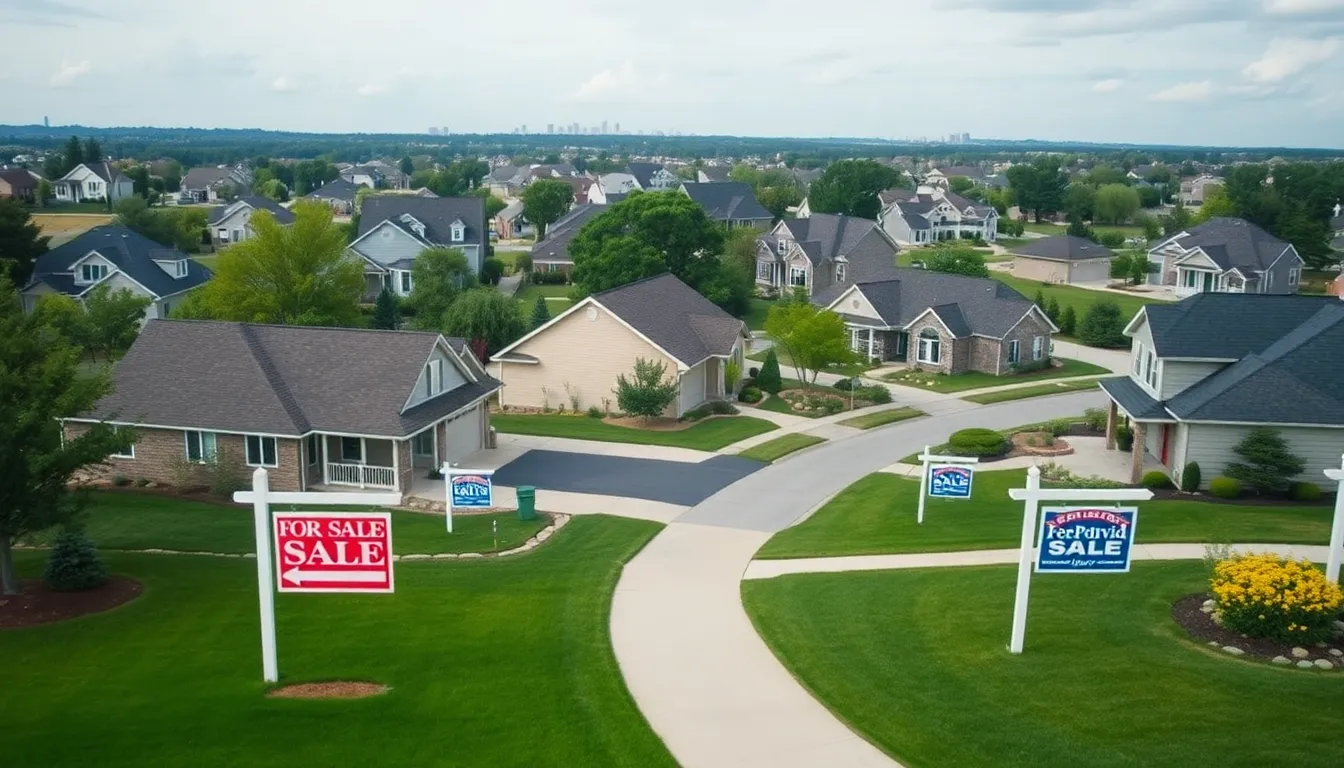In a world where avocado toast can cost more than a down payment, understanding current home prices has never been more crucial. Whether you’re a first-time buyer or a seasoned investor, the real estate market can feel like a rollercoaster ride—full of ups, downs, and the occasional loop-de-loop.
Table of Contents
ToggleOverview Of Current Home Prices
Current home prices reflect a volatile real estate market marked by significant regional variations. According to the National Association of Realtors, the median existing-home price in September 2023 reached $384,000, showing a 6.3% increase from the previous year. Urban centers often experience higher prices due to demand, while suburban and rural areas can offer more affordable options.
Interest rates greatly influence home prices. As of October 2023, the average mortgage rate sits around 7.5%, impacting affordability for many buyers. Higher interest rates can lead to lowered purchasing power, causing potential buyers to seek homes at lower price points.
Market analysis indicates that the supply of homes for sale remains below historical averages, exacerbating price increases. The shortage of available listings limits choices for buyers, contributing to competitive bidding situations in many markets. In contrast, some areas may see price reductions as sellers adjust expectations amidst shifting demand.
Local economies play a crucial role in determining home prices. In regions with stronger job growth and economic stability, home prices tend to rise. Conversely, markets experiencing economic downturn may see stagnant or decreasing home values.
Understanding these factors provides insight into current home prices. Buyers and investors must analyze local market conditions, interest rates, and economic indicators to make informed decisions. Awareness of these dynamics facilitates smarter real estate transactions in today’s unpredictable market.
Factors Influencing Current Home Prices

Current home prices are influenced by several key factors that shape the real estate landscape.
Interest Rates
Interest rates significantly affect home affordability and buyer purchasing power. As of September 2023, interest rates hover around 7.5%. Higher rates can deter buyers from entering the market. Lower rates typically encourage more purchasers, thus driving up demand and prices. Buyers navigating financing options often assess how interest rate fluctuations might impact their monthly payments and total cost over time.
Economic Conditions
Economic conditions play a vital role in determining home values. Job growth correlates with rising demand for housing, leading to increased home prices. When local economies thrive, more individuals seek to buy homes, driving competition. Conversely, economic downturns create uncertainty, often resulting in stagnant or even declining home values. Changes in unemployment rates and overall economic stability influence buyer confidence and real estate investment.
Supply and Demand
Supply and demand dynamics fundamentally shape the housing market. Currently, the supply of homes for sale remains below historical averages. This scarcity leads to competitive bidding in various markets. While urban areas face higher demand and prices, some suburban and rural locales may see price corrections as sellers adapt to changing buyer interests. Tracking local inventory levels provides insights into market trends and potential price movements.
Regional Variations In Current Home Prices
Current home prices vary significantly across different regions, influenced by factors like demand, supply, and local economies. Urban areas typically showcase higher median prices due to concentrated demand.
Urban vs. Rural Areas
Urban areas present a competitive landscape with median home prices often exceeding $500,000. Factors like employment opportunities, amenities, and infrastructure drive demand, making these locations pricier. In contrast, rural areas offer more affordability, with median prices around $250,000. The appeal of larger homes and lower living costs attracts buyers seeking value. While urban markets experience rapid price increases, rural regions often provide stability with slower appreciation rates. Hence, buyers should weigh preferences for urban convenience against rural tranquility.
High-Demand Markets
High-demand markets tend to see quicker sales and rising home prices. In September 2023, cities like San Francisco and New York boasted median prices nearing $1 million. Job growth and population influx contribute to this trend. Suburban markets near major cities also thrive, benefiting from remote work flexibility and commuting options. Areas such as Austin and Denver have gained traction, with prices up by over 10% in the last year. Buyers in these markets should expect fierce competition and potentially bidding wars, emphasizing the need for readiness in the purchasing process.
Future Predictions For Current Home Prices
Experts envision fluctuating trends in home prices amidst ongoing market volatility. They believe that various factors will dictate future pricing, including interest rates and economic conditions.
Expert Opinions
Real estate analysts assert that high interest rates, currently at around 7.5%, impact buyer affordability. Some predict a potential softening in prices if rates remain elevated. Others note that regional disparities may persist, with urban areas continuing to see higher prices due to sustained demand. Experts encourage monitoring job growth metrics, as these often correlate with price stability. They agree that a decline in consumer confidence could also shift market dynamics significantly. Professional forecasts indicate that competitive bidding in some markets may ease if price corrections materialize in response to declining buyer enthusiasm.
Market Trends
Current market dynamics show evolving trends impacting home prices across various regions. Lower inventory levels persist, driving demand in urban centers. Some suburban and rural markets may experience price adjustments as the allure of affordable homes remains strong. Activity in real estate continues to highlight the need for buyers to act swiftly in competitive situations. Analysts observe that remote work flexibility fuels demand in suburban locales, intensifying price competition. These trends suggest that while prices may stabilize in some areas, others might witness ongoing escalation, influenced by local economic health and buyer behavior.
Navigating the current housing market requires a keen understanding of fluctuating home prices. Buyers must stay informed about regional variations and the impact of interest rates on affordability. With the ongoing scarcity of inventory and competitive bidding in many areas, acting quickly is essential for those looking to secure a home.
As economic conditions evolve, so too will home prices. While some markets may stabilize, others could continue to see price increases driven by strong demand. Staying aware of local job growth and market trends will empower buyers to make informed decisions in this dynamic landscape.






